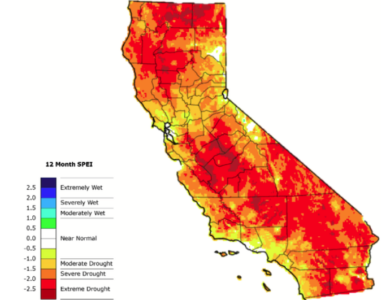
Drought measure would only apply to turfgrass adjacent to large industrial and commercial buildings.
Following the driest first three months of a year in California’s recorded history, Governor Gavin Newsom last week ordered the State Water Resources Control Board (SWRCB) to evaluate the adoption of regulations banning irrigation of “non-functional” turfgrass adjacent to large industrial and commercial buildings. The ban would not include residential lawns or grass used for recreation, such as school fields, sports fields, and parks. A copy of the executive order can be found here.
The Department of Water Resources (DWR) estimates this ban alone will result in potential water savings of several hundred thousand acre-feet. An acre-foot of water serves the needs of approximately three households for a year.
“While we have made historic investments to protect our communities, economy and ecosystems from the worsening drought across the West, it is clear we need to do more,” said Governor Newsom. “Today, I am calling on local water agencies to implement more aggressive water conservation measures, including having the Water Board evaluate a ban on watering ornamental grass on commercial properties, which will drive water use savings at this critical time. Amid climate-driven extremes in weather, we must all continue to do our part and make water conservation a way of life.”
The order called on the SWRCB to consider requiring urban water suppliers to activate, at a minimum, Level 2 of their customized Water Shortage Contingency Plans. These plans, required by state law, are developed by local water agencies to navigate drought. Triggering Level 2 of these plans involves implementing water conservation actions to prepare for a water shortage level of up to 20%. For example, in many communities, this would mean reducing the number of days that residents can water outdoors, among other measures.

Shortage Stats
Lack of snow is a major driver of the situation. On April 1, DWR conducted the fourth snow survey of the season at Phillips Station and recorded just 2.5″ of snow depth and a snow water equivalent of 1″, which is 4% of average for this location and date. In a normal season, the snowpack depth would be about five feet deep at this time of year.
Dry conditions are impacting every region of the state, as the Northern, Central, and Southern Sierra snowpacks are all standing just above 28% to 43% of average for this date. April 1 is typically when the snowpack is at its highest, however the statewide snowpack likely peaked in early-March this year and the Northern Sierra snowpack peaked in mid-January. Statewide, the snowpack is just 38% of average for this date.
“The conditions we are seeing today speak to how severe our drought remains. DWR has been planning for the reality of a third dry year since the start of the water year on October 1,” said DWR Director Karla Nemeth. “While DWR has made significant investments in forecasting technology and other tools to ensure we make the most out of the snowmelt we do receive, water conservation will remain our best tool in the face of this ongoing drought and the statewide impacts of a warming climate. All Californians must focus on conserving water now.”
More information on the state’s response to the drought and informational resources available to the public are available at https://drought.ca.gov/.
Chart: WestWide Drought Tracker, U Idaho/WRCC, Data Source: PRISM (Prelim), created April 2, 2022.
Photos: Kenneth James / California Department of Water Resources
For an article on “Warm Season Grasses And Water Conservation In California,” click here.











![[VIDEO] Dickies®: Discover Workwear That’s Anything But Uniform](https://turfmagazine.com/wp-content/uploads/2023/06/1647663814-4b1a2a7742790a9b1e97a3b963477850192e1d6a9dfba9b07214a77bae25d6e3-d-218x150.jpg)





























![[VIDEO] Dickies®: Discover Workwear That’s Anything But Uniform](https://turfmagazine.com/wp-content/uploads/2023/06/1647663814-4b1a2a7742790a9b1e97a3b963477850192e1d6a9dfba9b07214a77bae25d6e3-d-324x160.jpg)